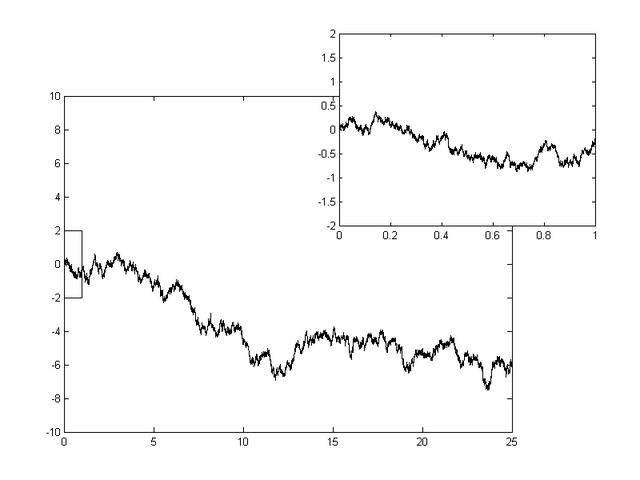위너 확률 과정
위키백과, 무료 백과사전
확률 과정 이론에서, 위너 확률 과정(Wiener確率過程, 영어: Wiener stochastic process) 또는 위너 과정(Wiener過程)은 시간차 의 증분의 확률 분포가 평균 0, 분산 의 정규 분포를 이루며, 각 증분이 서로 독립이며, 그 궤적이 거의 확실하게 연속적인 연속 시간 확률 과정이다.

정의
요약
관점
다음이 주어졌다고 하자.
이 다음 조건들을 만족시킨다면, 위너 확률 과정(영어: Wiener stochastic process)이라고 한다.
연산
요약
관점

위너 확률 과정 이 주어졌을 때, 확률 과정
역시 위너 확률 과정을 이룬다. 즉, 그 그래프는 일종의 프랙털을 이룬다.
가 유클리드 공간 값의 위너 확률 과정이라고 하자. 그렇다면, 임의의 부분 벡터 공간 에 대하여, 역시 값의 위너 확률 과정이다.
임의의 직교 행렬 및 값의 위너 확률 과정 에 대하여, 역시 값의 위너 확률 과정이다.
예
요약
관점
다음이 주어졌다고 하자.
그렇다면, 임의의 에 대하여, 급수
는 (의 거리 위상에서) 수렴한다. (여기서 는 폐구간의 지시 함수이다.) 이는 위너 확률 과정의 정의를 거의 확실한 연속성만을 제외하고 모두 만족시킨다.
만약 정규 직교 기저를
로 잡는다면, 위 급수가 에 대하여 균등 수렴하는 것을 보일 수 있으며, 이 경우 이 급수는 위너 확률 과정을 이룬다.
역사
노버트 위너의 이름을 땄다.
같이 보기
외부 링크
- Weisstein, Eric Wolfgang. “Wiener process”. 《Wolfram MathWorld》 (영어). Wolfram Research.
- “Wiener process”. 《Encyclopedia of Mathematics》 (영어). Springer-Verlag. 2001. ISBN 978-1-55608-010-4.
Wikiwand - on
Seamless Wikipedia browsing. On steroids.






























![{\displaystyle \operatorname {L} ^{2}([0,1],\mathbb {R} )}](http://wikimedia.org/api/rest_v1/media/math/render/svg/3c4239dd8987d73e42f45121ba5c18872d1b3b1d)
![{\displaystyle (f_{i}\colon [0,1]\to \mathbb {R} )_{i\in I}}](http://wikimedia.org/api/rest_v1/media/math/render/svg/a923f307d25ebaeedfac90a772bef6b379084a6e)


![{\displaystyle t\in [0,1]}](http://wikimedia.org/api/rest_v1/media/math/render/svg/31a5c18739ff04858eecc8fec2f53912c348e0e5)
![{\displaystyle W(t)=\sum _{i\in I}X_{i}\langle 1_{[0,t]}|f_{i}\rangle _{\operatorname {L} ^{2}([0,1],\mathbb {R} )}\in \operatorname {L} ^{2}([0,1],\mathbb {R} )}](http://wikimedia.org/api/rest_v1/media/math/render/svg/aad95aa2305e6c1ce66fcbc658450caf7336b94f)
![{\displaystyle 1_{[0,t]}}](http://wikimedia.org/api/rest_v1/media/math/render/svg/bc6202149d1ad8c26cbf68e3562bbb0a9e582bfc)
